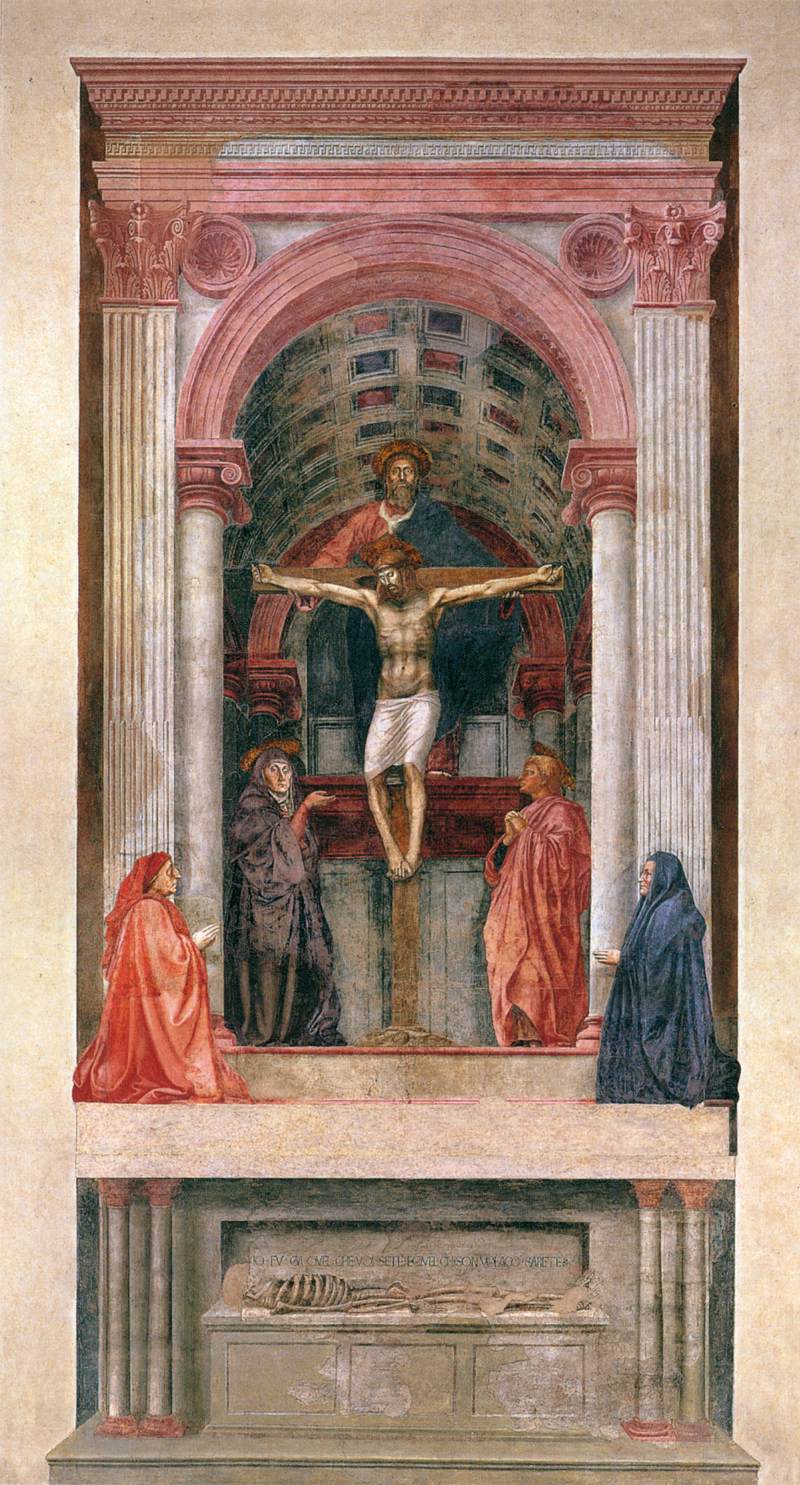Not all images are intended to have a dual nature, and for a long time, prior to the Renaissance in Europe, many works of visual art appear to have been intended to be arrangements of flat symbols, closer to writing than to realist painting.

The objects depicted within this miniature, telling the story of Rebecca and Eliezer at the well, are not scaled relative to their physical size, only placed in depth order. Relative size is one of the most basic and strongest clues which visual perception uses to interpret 2D images into 3D, and was thoroughly understood long before ancient Roman and Greek art.

Although the Romans loved the trompe l’oeil, no surviving work of visual art from Roman times comes close to demonstrating an understanding of modern perspective projection. We cannot know whether those who saw this fresco in the Villa of P. Fannius Synistor, in Boscoreale, Italy, would have recognised the incoherence of it perspective projection, though.
Before 265 BCE, Euclid established the geometrical and optical principles necessary to perform modern perspective projection, but amazingly neither he nor successors such as Hero or Ptolemy quite reached it. It also eluded the polymath Roger Bacon in the thirteenth century.

Painted just a century before the discovery of modern perspective projection, works like Duccio’s Healing of the Man Born Blind appear very odd to the modern ‘eye’. Aside from its multiplex narrative, in which the blind man is shown standing next to himself, Duccio’s inability to project the lines of the buildings to coherent vanishing points now appears amateur or slapdash. At the time, just as in Roman urban views, it must have seemed far more ‘natural’, though.

Over the same period, the development of sophisticated and highly-detailed visual art in Asia arrived at a slightly different solution, now known as the oblique projection. Whereas Roman and subsequent European visual art effectively had multiple and incoherent vanishing points, Asian art usually lacked any vanishing point, but aligned recession in parallel. An important factor here is the use of long scrolls, which even now make fully coherent perspective projection unsuitable.

Oblique projections still work well along the length of a scroll, as in any sectional view they are close to a modern, more coherent projection.
Recent very extensive scientific investigations of visual perception, painstakingly analysed by Wagner and others, have concluded that humans in the latter half of the twentieth century perceive the world in a projection which is close to – but not identical with – modern perspective projection.
There is, though, essentially no useful evidence as to whether that has always been the case, or whether such a perceptual model is influenced or determined by exposure to 2D images during early life.

It was, of course, the Florentine architect Filippo Brunelleschi who first arrived at modern coherent perspective projection, and the first substantial painting (to have survived) which employed his system was Masaccio’s magnificent The Holy Trinity (1426-8) in the Basilica of Santa Maria Novella in Florence.
Response to this, and other contemporary paintings which employed the projection, was telling. Despite the geometric challenges, and the lack of published methods, modern perspective projection spread rapidly and became very widely adopted throughout Europe. Within a few decades, representational drawing and painting was expected to conform to modern projection, it was exploited in wall and ceiling paintings in huge trompes l’oeil, and the most skilled artists took on challenges such as extreme foreshortening.
Most significantly, modern perspective projection arrived at a time of increasing urbanisation, when rectilinear objects were becoming increasingly important in representational art, and it is likely that earlier incoherent projections were looking increasingly incorrect.

For the next half millenium or so, modern perspective projection was the accepted standard for almost all representational 2D art. The introduction of photography in the nineteenth century initially strengthened this dependence, as comparisons were made between the ‘fidelity’ of photographic and drawn/painted images. The changes brought by Impressionism only strengthened this position.

It is often claimed that the post-Impressionist paintings of Paul Cézanne were an exception to this, in abandoning many of the conventional cues used to impart depth and give a painting its dual perception. Cézanne’s own statements on what he intended to achieve are unclear, and often contradict what he showed in his paintings.
Extensive speculation since his death has been of very limited value, as its hypotheses are largely untestable. However, careful examination of his work shows that even a few months before his death, at least some of his paintings largely adhered to the conventions of modern perspective projection, as seen in his Le Cabanon de Jourdan (1906), above and below.

The year after Cézanne painted that, and died, brought the birth of Cubism, in some initial explorations by Pablo Picasso and Georges Braque. For the first time in almost five hundred years, representational paintings were deliberately flaunting their violation of perspective projection.
The result was perceptually strange, transient in popularity, and did nothing to replace modern perspective projection, which has remained central to representational art. With the wisdom of hindsight, it was a short-lived experiment which brought no lasting change.
Had Brunelleschi and Masacchio developed Cubism instead of modern perspective projection, and had that held sway for four hundred years before the arrival of photography, the history of art should have been very different. Instead, the Renaissance introduced an approach to perspective which is based on the geometric optics of the physical world, and in very close accord with our internal perceptual model.
The persistence and pervasiveness of modern perspective projection is so strong and deep that it must have good perceptual support. But I also suspect that it is reinforced by exposure to projected images, and that we could perhaps equally accommodate to oblique and other projections.
References
Wagner M (2006) The Geometries of Visual Space, Psychology Press. ISBN 978 0 8058 5253 0.
Summary of series on this blog on the depiction of space in 2D art.

